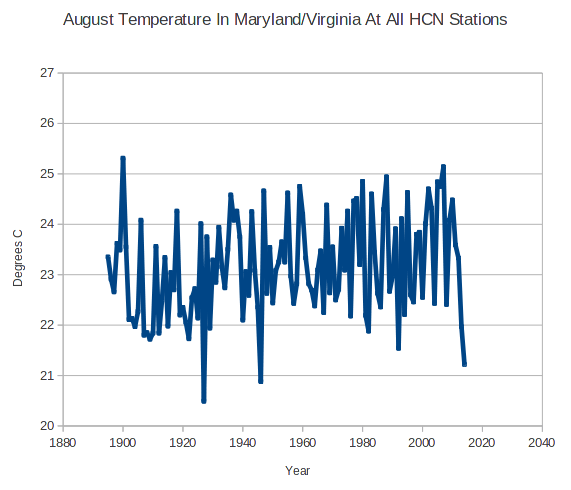So far, August temperatures around DC are third coolest on record and the coolest in almost 70 years. The hottest August occurred in the year 1900.
Disrupting the Borg is expensive and time consuming!
Google Search
-
Recent Posts
- Fact Checking The New York Times
- New Visitech Features
- Ice-Free Arctic By 2014
- Debt-Free US Treasury Forecast
- Analyzing Big City Crime (Part 2)
- Analyzing Big City Crime
- UK Migration Caused By Global Warming
- Climate Attribution In Greece
- “Brown: ’50 days to save world'”
- The Catastrophic Influence of Bovine Methane Emissions on Extraterrestrial Climate Patterns
- Posting On X
- Seventeen Years Of Fun
- The Importance Of Good Tools
- Temperature Shifts At Blue Hill, MA
- CO2²
- Time Of Observation Bias
- Climate Scamming For Profit
- Climate Scamming For Profit
- Back To The Future
- “records going back to 1961”
- Analyzing Rainfall At Asheville
- Historical Weather Analysis With Visitech
- “American Summers Are Starting to Feel Like Winter”
- Joker And Midnight Toker
- Cheering Crowds
Recent Comments
- Bob G on Fact Checking The New York Times
- arn on Fact Checking The New York Times
- conrad ziefle on Fact Checking The New York Times
- arn on Fact Checking The New York Times
- Bob G on Fact Checking The New York Times
- conrad ziefle on Fact Checking The New York Times
- Bob G on Fact Checking The New York Times
- czechlist on Fact Checking The New York Times
- conrad ziefle on Fact Checking The New York Times
- Bob G on Fact Checking The New York Times



Cooling brought to you by UN-IPCC in association with Hypothecated CO2 Mediated Global Warming Ponzi Schemes LLC™(China) , proud sponsors of –
Endeavoring. Those red underlines from your spellchecker mean something.
no
Yea,they mean my spelling still sucks! 😉
We are not too bad 90 miles south either! Bit humid today, but temps of only 80 make it fine for August!
We are enjoying a week of 80’s in Cal in Aug!! Unprecedented !!!
Another argument that suggests there is not a systematic bias with older thermometers that needs to be fixed by cooling the past is the fact that 1900 was nearly 3 degrees warmer than a few years later. You have a big dip a few years after a big jump. Suggests that the high readings in 1900 ae not an artifact. I guess you could still have a systematic bias but then cooling the past makes 1903 (or whatever year that is) even colder.
Washington National, the designated DC area alarmist poster child, is averaging only 1.1 degrees below normal so far this August. Baltimore Washington International is averaging 3.1 degrees below normal and Dulles is averaging 3.8 degrees below normal. Any reasonable person would simply throw National’s observations in the toilet, but instead, it is given high status as the “official” DC area weather station. Even though similar differences have showed up every single month this year. What a total farce!
One day last week they reported 90 degrees at Washington National, and it never got over 81 in Gaithersburg that day.
They set up a barbeque grill next to the thermometer station at Washington National.
Sounds about right these days. 🙂
A photo is sometimes worth a thousand words. So are questions. Jo Nova asks Why Do They Measure Temperature Like This?
The Surace Station Org gives an idea of what the actual error is in the readings. Keep in mind that the USA supposedly has the ‘BEST’ surface station quality. We have spent billions on ‘Climate research’ and haven’t bothered to make sure of the quality of the readings???? (WTH!)
So what is the error?
6.2% error >=5 °C
64.4% error >=2 °C
21.5% error >=1 °C
That leaves only 1.2% with the error less than 1 °C.